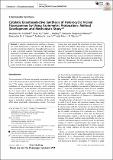Files in this item
Catalytic enantioselective synthesis of heterocyclic vicinal fluoroamines using asymmetric protonation : a method development and mechanistic study
Item metadata
| dc.contributor.author | Ashford, Matthew | |
| dc.contributor.author | Xu, Chao | |
| dc.contributor.author | Molloy, John J. | |
| dc.contributor.author | Carpenter-Warren, Cameron Lewis | |
| dc.contributor.author | Slawin, Alexandra Martha Zoya | |
| dc.contributor.author | Leach, Andrew G. | |
| dc.contributor.author | Watson, Allan J. B. | |
| dc.date.accessioned | 2020-08-19T09:30:03Z | |
| dc.date.available | 2020-08-19T09:30:03Z | |
| dc.date.issued | 2020-09-21 | |
| dc.identifier | 268490951 | |
| dc.identifier | dc0a9bc4-9743-42c2-a200-40d999a23816 | |
| dc.identifier | 000560365600001 | |
| dc.identifier | 85089537153 | |
| dc.identifier.citation | Ashford , M , Xu , C , Molloy , J J , Carpenter-Warren , C L , Slawin , A M Z , Leach , A G & Watson , A J B 2020 , ' Catalytic enantioselective synthesis of heterocyclic vicinal fluoroamines using asymmetric protonation : a method development and mechanistic study ' , Chemistry - A European Journal , vol. 26 , no. 53 , pp. 12249-12255 . https://doi.org/10.1002/chem.202002543 | en |
| dc.identifier.issn | 0947-6539 | |
| dc.identifier.other | ORCID: /0000-0002-9527-6418/work/79226755 | |
| dc.identifier.other | ORCID: /0000-0002-1582-4286/work/79226951 | |
| dc.identifier.uri | https://hdl.handle.net/10023/20485 | |
| dc.description | Funding: Leverhulme Trust (Grant Number(s): RPG-2015-308), University of St Andrews, University of Manchester. | en |
| dc.description.abstract | A catalytic enantioselective synthesis of heterocyclic vicinal fluoroamines is reported. A chiral Brønsted acid promotes aza‐Michael addition to fluoroalkenyl heterocycles to give a prochiral enamine intermediate that undergoes asymmetric protonation upon rearomatization. The reaction accommodates a range of azaheterocycles and nucleophiles, generating the C−F stereocentre in high enantioselectivity, and is also amenable to stereogenic C−CF3 bonds. Extensive DFT calculations provided evidence for stereocontrolled proton transfer from catalyst to substrate as the rate‐determining step, and showed the importance of steric interactions from the catalyst's alkyl groups in enforcing the high enantioselectivity. Crystal structure data show the dominance of noncovalent interactions in the core structure conformation, enabling modulation of the conformational landscape. Ramachandran‐type analysis of conformer distribution and Protein Data Bank mining indicated that benzylic fluorination by this approach has the potential to improve the potency of several marketed drugs. | |
| dc.format.extent | 8 | |
| dc.format.extent | 1608660 | |
| dc.language.iso | eng | |
| dc.relation.ispartof | Chemistry - A European Journal | en |
| dc.subject | Asymmetric | en |
| dc.subject | Brønsted acid | en |
| dc.subject | Catalysis | en |
| dc.subject | Fluorine | en |
| dc.subject | Heterocycles | en |
| dc.subject | QD Chemistry | en |
| dc.subject | DAS | en |
| dc.subject.lcc | QD | en |
| dc.title | Catalytic enantioselective synthesis of heterocyclic vicinal fluoroamines using asymmetric protonation : a method development and mechanistic study | en |
| dc.type | Journal article | en |
| dc.contributor.sponsor | The Leverhulme Trust | en |
| dc.contributor.institution | University of St Andrews. Sir James Mackenzie Institute for Early Diagnosis | en |
| dc.contributor.institution | University of St Andrews. School of Chemistry | en |
| dc.contributor.institution | University of St Andrews. EaSTCHEM | en |
| dc.identifier.doi | https://doi.org/10.1002/chem.202002543 | |
| dc.description.status | Peer reviewed | en |
| dc.identifier.url | https://doi.org/10.26434/chemrxiv.11920947.v1 | en |
| dc.identifier.grantnumber | RPG-2015-308 | en |
This item appears in the following Collection(s)
Items in the St Andrews Research Repository are protected by copyright, with all rights reserved, unless otherwise indicated.

